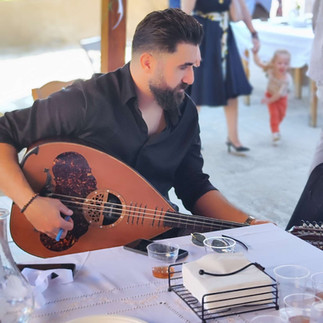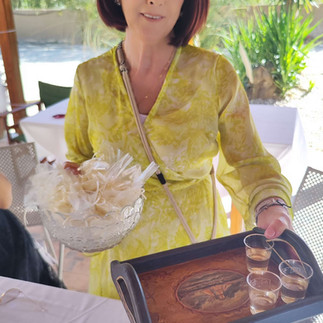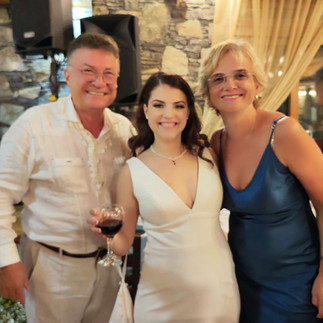A Cretan Wedding"I Zoi Ine Gamos" – Life is a Wedding.
- Murat Igcioglu
- Nov 4
- 8 min read
Producer, Editor, Photograps and Videos: Murat İĞCİOĞLU - @murati2021

Eleanna Pitsikaki- Alex Zatse
27 October 2025
You can access the photos and videos of Eleanna and Alexandros's magnificent, unforgettable wedding through the links below:
Pre-wedding celebration at home days before the wedding:https://www.facebook.com/share/v/1FwoRvQp67/
The Wedding - Bidding farewell to the bride, leaving home, and going to the Church:https://www.facebook.com/share/v/1Koahs1QZT/
Wedding Celebration - Post-church evening celebration and fun:https://www.facebook.com/share/v/1BKcbS3P2W/
A Cretan wedding offers its participants not just a celebration, but a living cultural experience. Every stage is filled with meaningful rituals, every rhythm with heartfelt music, and every morsel with sharing and abundance. These weddings are an unforgettable feast where the Cretan spirit – hospitable, proud, free, and full of life – manifests itself in its most vibrant form. As the Cretans say: "I Zoi ine Gamos" – Life is a Wedding.
We met the Pitsikaki family in 2012, and a friendship beyond family, a closeness beyond siblings, and a trust beyond companionship formed between us. Their efforts for me and my friends have been immense. They are such world citizens, having touched their own circles and thousands of people, that they deserve to be the subject of a special study, even a research on exemplary lifestyles for world history. Because our world, in its rapid pursuit of consumption, has pushed aside traditions, respect, and love, chasing after new trends. Our friends Eva and Konstantinos, however, by placing human love at the foundation of Cretan tradition, truly deserve special applause and recognition for sharing and preserving culture. Their language and philosophy pass through "Love is Labor." We thank the whole family very much.
We shared in the love and joy of the Pitsikaki family's third wedding. We attended the weddings of their niece in 2013, their middle child Alexandros Pitsikakis - Maria in 2016, and their youngest child Eleanna Pitsikaki - Alex Zatse on October 27, 2024. (I cannot fail to mention the eldest, Grigoris - Marilena Pitsikakis. A tremendous couple and family.) They are all very talented, well-raised, good people, and individuals who have become citizens of the world. We heartily congratulate them and the family, wishing them everlasting happiness, and embrace them with love.
Having seen so many Traditional Cretan Weddings, I had to write about this experience. I will not write the wedding details; below are the compiled details of a Traditional Cretan Wedding. Furthermore, the Photos and Videos I took at the wedding, during the preparations, and beforehand already document everything.
A Feast That Will Last a Lifetime: The Unique Journey of a Traditional Cretan Wedding
After the azure waters, green olive groves, and historic peaks that come to mind with Crete, perhaps the most remembered are the vibrant weddings that reflect the island's soul. A Cretan wedding is not just the union of two people, but also a feast lasting days where families, villages, and even entire regions come together; where the past, music, food, and dance intertwine. In this article, we take you into the depths of a traditional Cretan wedding.
Pre-Wedding Preparations: From "Proxenio" to "Krevati"
Pre-Marriage Arrangements (Proxenio): More common in the past, this tradition involved formal negotiations between families. Today, although couples mostly make their own decisions, family approval and happiness still hold great importance.
Engagement (Arrahes): The engagement ceremony is the first major celebration on the path to marriage. Families and close friends gather, meals are shared, wine is drunk, and the couple exchanges rings. This is the herald of the wedding joy.
Dowry and Bed Making (Krevati): Just before the wedding, the bride's friends and family prepare the bed in their new home. This ritual is quite fun and symbolic. A baby (usually a boy) is rolled on the bed to wish the couple a life full of children. Money, rice, and leaves are sprinkled to wish for prosperity and abundance.
The Wedding Day: Joy and Rituals
1. Attire:
Bride: The bride, wearing her traditional costume (especially the 19th-century "Sariki" and "Festia"), is adorned with embroideries, gold ornaments, and precious jewelry. A red veil (tsemberi), symbolizing her virginity and purity, is placed on her head.
Groom: The groom typically wears black trousers, an embroidered waistcoat (meidanogileko), boots decorated with laces (stivania), and a headscarf (sariki). This attire reflects the pride and nobility of the Cretan man.
2. The Church Ceremony (Stéfanoma): The wedding procession walks or drives to the church with all the guests. The ceremony in the church is conducted according to Orthodox tradition. Crowns (stefana) are placed on the couple's heads, symbolizing unity and the grace of the Holy Spirit. These crowns are exchanged three times over their heads by the "Best Man" (Koumbaros). The ceremony continues with prayers, readings from the Gospel, and the ritual of the couple drinking wine.
3. The Wedding Feast and Banquet (Gamos): After leaving the church, the joy peaks. Guests go to the wedding venue, usually set up in the village square, a countryside taverna, or a large garden. A massive feast awaits them there.
Food: All the delicacies of Cretan cuisine adorn the tables:
Antikristo: The most important dish of the wedding. Usually a lamb or kid, split in half and grilled. This signifies that the couple will "share" their lives.
Hondros: A traditional dish made with goat or lamb meat, prepared with frumenty or orzo.
Raki (Tsikoudia/Raki): Crete's grape spirit is a must at weddings. It is continuously offered, and with every "Yia mas!" (Cheers!), the joy increases.
Various mezes, cheeses (graviera, mizithra), pastries (kalitsounia), and fresh vegetables decorate the table.
Of course, Red, rosé and white wines are always on the tables.
At home, the father inevitably boils and offers a goat or kid, adding his own effort to the day by making rice pilaf with the broth. That special rice pilaf made at home and awaited by everyone at Cretan weddings is actually not the plain rice pilaf we know. This is a traditional dish called "Hondros" (Χόνδρος) or "Hondros tou Gamou" (Γάμου Χόνδρος - Wedding Hondros), one of the symbolic foods of the wedding.
Hondros (Wedding Pilaf): Symbol of Abundance and Feast
What is Hondros?Hondros is not rice, but can be thought of as a type of large-grain couscous or "frik" made from wheat. It is the dried form of cut or crushed wheat used traditionally to make "Trahanas" (Tarhana). It has a firmer texture and a slightly nutty taste than rice. Therefore, the "wedding pilaf" is actually a "wheat pilaf".
Why is this Dish so Important?
Symbol of Abundance: Wheat has been a symbol of fertility and proliferation for thousands of years. Each grain of Hondros represents the wish for the couple to have a life full of abundance.
Feeding the Crowds: A Cretan wedding can have hundreds, sometimes thousands of guests. Hondros is an affordable, filling, and easily cooked in large cauldrons. It is, in a sense, a practical expression of generosity and hospitality.
The Taste of the Past: This recipe has been passed down through generations. Its taste is a piece of childhood and all wedding memories for Cretans; it carries a sense of nostalgia and belonging.
How is Hondros Made?The preparation of Hondros is one of the most important rituals of the wedding. Usually, the day before the wedding, the experienced women of the neighborhood or family gather and cook this dish together in large cauldrons.
Ingredients: Hondros (Cracked wheat/trahanas grains), Meat Broth (prepared from the bones and meat leftovers of the "Antikristo" main dish, a very tasty and rich broth), Lamb or Goat Meat (usually chopped into small pieces), Onion, Olive Oil (of course, Cretan virgin olive oil), Spices (Salt, pepper, and especially "Rigani" - Cretan thyme).
Preparation: Onions are sautéed in olive oil in a large cauldron. Diced meat is added and cooked until browned. Hondros is added and sautéed for a few more minutes. Warm broth is added gradually, stirring constantly with a wooden spoon until it reaches a pilaf consistency. Finally, rigani and other spices are added.
Result: The resulting dish is a "pilaf" with a firmer and more distinct texture than rice pilaf, infused with the exquisite aroma of meat and rigani, extremely satisfying and delicious. It is served at the wedding feast on huge platters or from cauldrons to fill the guests' plates.
In summary:The "rice pilaf" made at home in Cretan weddings is actually not rice, but cracked wheat called "Hondros". This dish symbolizes abundance and fertility, is the most traditional and practical way to feed large wedding crowds, harmonizes with the main wedding meat dish (Antikristo), and is an example of community solidarity; it is prepared and eaten together.
Music and Dance: The Heartbeat of the Wedding
The most fundamental element that distinguishes a Cretan wedding is undoubtedly its music. The wedding takes place with a "Lira" and "Laouto" (lyra and lute) band playing lively Cretan music.
Pidiktos (Standing Dance): The wedding begins with the groom asking the bride to dance. Then all the guests, holding hands, form a large circle.
Pentozalis and Sirtos: The most famous and energetic dances of Crete. Dancers form a circle around the musicians, and the leader (protosoraris) performs complex figures. The tempo of the dance gradually increases, and the excitement peaks.
Money Throwing Tradition (Sta Vourá): Throwing money onto the dancing couple and the musicians is one of the most well-known customs of Cretan weddings. This is a gift, appreciation, and wish for abundance given to the couple and musicians. Sometimes, dancing takes place on the scattered money.
Symbol of the Dance: Cretan dances are not just entertainment, but also a display of solidarity, unity, and the Cretan spirit. Every step recalls the island's historical resistance and love of freedom.
Firing Guns (Stupés)
In Cretan weddings, especially on the way to the church and within the wedding procession, firing guns into the air (called "Stupés") is one of the island's most striking, exciting, and deep-rooted traditions. This custom is an integral part of Cretan culture and history. It is a symbol of joy, pride, freedom, and a way to ward off evil. However, it is governed by unwritten rules (always firing safely into the air, away from crowds) and faces legal restrictions and safety concerns in modern times, leading to more controlled and symbolic practice.
Post-Wedding: A New Life
The wedding feast can last until the first light of dawn. The couple is taken to their home to start their new life. The noise and joy of the Cretan wedding remain etched in their memories as a lifelong memory.
Conclusion
A Cretan wedding offers its participants not just a celebration, but a living cultural experience. Every stage is filled with meaningful rituals, every rhythm with heartfelt music, and every morsel with sharing and abundance. These weddings are an unforgettable feast where the Cretan spirit – hospitable, proud, free, and full of life – manifests itself in its most vibrant form. Amidst the smoke of Antikristo, the melancholic yet equally joyful sound of the lyra, the rhythm of pentozalis, and the cheers of "Yia mas!", the powerful spirit of Crete comes to life once more. These weddings are an unforgettable bridge between the past and the future, woven with music and dance.
As the Cretans say: "I Zoi ine Gamos" – Life is a Wedding.
You can access the photos and videos of Eleanna and Alexandros's magnificent, unforgettable wedding through the links below:
Pre-wedding celebration at home days before the wedding:https://www.facebook.com/share/v/1FwoRvQp67/
The Wedding - Bidding farewell to the bride, leaving home, and going to the Church:https://www.facebook.com/share/v/1Koahs1QZT/
Wedding Celebration - Post-church evening celebration and fun:https://www.facebook.com/share/v/1BKcbS3P2W/
@evakoutsogiannaki @eleannapitsikaki @girgorispitsikakis @istanbulgiritlilerdernegi @murati2021 #creta #cretawedding #Greece #Greek #heraklion
@evakoutsogiannaki @eleannapitsikaki @grigorispitsikakis













































































































Comments